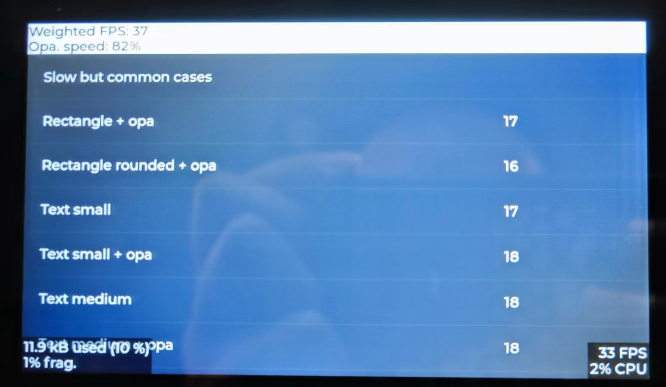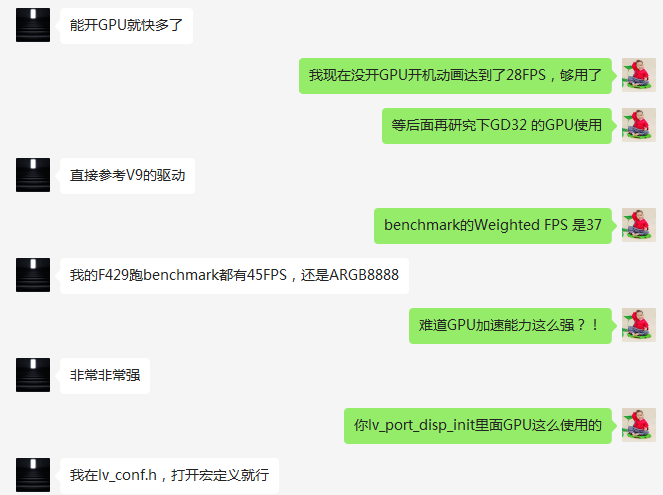1、硬件对比
屏幕尺寸: 800*480
颜色格式: RGB565
一帧数据: 800*480*2 = 768000 = 750k
LCD 频率 : 32MHz/768000 = 41 HZ
lvgl fps : 33
优化等级: AC5-O3
新硬件:GD32F470II
SDRAM : 32bit带宽 ,120MHz
MCU: 240MHz, 768K RAM, 2M Flash
lv_demo_benchmark()的结果如下:

老硬件:GD32F450zg
SDRAM : 16bit带宽 ,100MHz
MCU: 200MHz, 256K RAM, 1M Flash
lv_demo_benchmark()的结果如下:

而跑我自己的开机动画则是如下情况:

可以看到新版硬件比老版本速度提升了3倍,显然MCU那40MHz并不是主力,大部分是32Bit SDRAM起到的功劳。
这里的结论就是,800*480 的屏至少32Bit SDRAM起步,否则就只能播放下PPT。
驱动方面对帧率的影响也非常大,下面把几个主流的驱动方式贴出来做对比。
2、驱动对比
1、GD32官方驱动
核心就两个函数
1 void lv_port_disp_init(void) 2 { 3 /*------------------------- 4 * Initialize your display 5 * -----------------------*/ 6 disp_init(); 7 8 /*----------------------------- 9 * Create a buffer for drawing 10 *----------------------------*/ 11 12 static lv_disp_buf_t draw_buf_dsc_2; 13 static lv_color_t draw_buf_2_1[COLOR_BUF_SIZE] __attribute__((at(0xC0080000))); 14 static lv_color_t draw_buf_2_2[COLOR_BUF_SIZE] __attribute__((at(0xC0100000))); 15 lv_disp_buf_init(&draw_buf_dsc_2, draw_buf_2_1, draw_buf_2_2, COLOR_BUF_SIZE); /*Initialize the display buffer*/ 16 17 /*----------------------------------- 18 * Register the display in LVGL 19 *----------------------------------*/ 20 21 lv_disp_drv_t disp_drv; /*Descriptor of a display driver*/ 22 lv_disp_drv_init(&disp_drv); /*Basic initialization*/ 23 24 /*Set up the functions to access to your display*/ 25 26 /*Set the resolution of the display*/ 27 disp_drv.hor_res = LV_HOR_RES_MAX; 28 disp_drv.ver_res = LV_VER_RES_MAX; 29 30 /*Used to copy the buffer's content to the display*/ 31 disp_drv.flush_cb = disp_flush; 32 33 /*Set a display buffer*/ 34 disp_drv.buffer = &draw_buf_dsc_2; 35 36 rcu_periph_clock_enable(RCU_IPA); 37 38 #if LV_USE_GPU 39 /*Optionally add functions to access the GPU. (Only in buffered mode, LV_VDB_SIZE != 0)*/ 40 41 /*Blend two color array using opacity*/ 42 disp_drv.gpu_blend_cb = gpu_blend; 43 44 /*Fill a memory array with a color*/ 45 disp_drv.gpu_fill_cb = gpu_fill; 46 #endif 47 48 /*Finally register the driver*/ 49 lv_disp_drv_register(&disp_drv); 50 51 #ifdef USE_IPA_INT 52 nvic_irq_enable(IPA_IRQn, 0, 1); 53 #endif 54 }
1 static void disp_flush(lv_disp_drv_t * disp_drv, const lv_area_t * area, lv_color_t * color_p) 2 { 3 /*The most simple case (but also the slowest) to put all pixels to the screen one-by-one*/ 4 #ifndef USE_IPA_INT 5 uint32_t time_out; 6 #endif 7 uint16_t offline; 8 offline = LV_HOR_RES_MAX - (area->x2 - area->x1 + 1); 9 10 IPA_CTL = 0x0; 11 IPA_FMADDR = (uint32_t)color_p; 12 IPA_DMADDR = (uint32_t)(uint32_t)LCD_FRAME_BUFFER + 2*(LV_HOR_RES_MAX*area->y1+area->x1); 13 IPA_FLOFF = 0; 14 IPA_DLOFF = offline; 15 IPA_FPCTL = FOREGROUND_PPF_RGB565; 16 IPA_IMS = (uint32_t)((area->x2 - area->x1 + 1) << 16) | (uint16_t)(area->y2 - area->y1 + 1); 17 18 #ifdef USE_IPA_INT 19 g_disp_drv = disp_drv; 20 /* enable IPA interrupt */ 21 IPA_CTL |= IPA_CTL_FTFIE | IPA_CTL_TAEIE | IPA_CTL_WCFIE; 22 IPA_CTL |= IPA_CTL_TEN; 23 g_ipa_flag = 1; 24 #else 25 IPA_CTL |= IPA_CTL_TEN; 26 /* Wait until transfer is done */ 27 while (IPA_CTL & IPA_CTL_TEN) 28 { 29 if(time_out++ >= 0XFFFFFFFF) break; 30 } 31 32 /* IMPORTANT!!! 33 * Inform the graphics library that you are ready with the flushing*/ 34 lv_disp_flush_ready(disp_drv); 35 #endif 36 }
我使用的就是这个代码,达到的效果就是上面看到的
2、2个图层互切
1 static void DEMO_FlushDisplay(lv_disp_drv_t * disp_drv, const lv_area_t * area, lv_color_t * color_p) 2 { 3 if (color_p == buf2_1) 4 { 5 tli_layer_disable(LAYER0); 6 tli_layer_enable(LAYER1); 7 tli_reload_config(TLI_REQUEST_RELOAD_EN); 8 } 9 else if (color_p == buf2_2) 10 { 11 tli_layer_disable(LAYER1); 12 tli_layer_enable(LAYER0); 13 tli_reload_config(TLI_REQUEST_RELOAD_EN); 14 } 15 16 /* IMPORTANT!!! 17 * Inform the graphics library that you are ready with the flushing*/ 18 lv_disp_flush_ready(disp_drv); 19 }
这种方式我没有成功,因为设置两个图层后,我的layer1不显示,只有layer0显示,也不知道为什么。而且其速度应该跟3相似,所以也没有特别考究。
3、LCD和LVGL公用双buf
1 void lv_port_disp_init(void) 2 { 3 /*------------------------- 4 * Initialize your display 5 * -----------------------*/ 6 disp_init(); 7 8 /*----------------------------- 9 * Create a buffer for drawing 10 *----------------------------*/ 11 /* Example for 3) also set disp_drv.full_refresh = 1 below*/ 12 static lv_disp_draw_buf_t draw_buf_dsc_3; 13 static lv_color_t *buf_3_1 = (lv_color_t * )(LVGL_MemoryAdd); /*A screen sized buffer*/ 14 static lv_color_t *buf_3_2 = (lv_color_t * )(LVGL_MemoryAdd + LCD_Width*LCD_Height*sizeof(lv_color_t)); /*Another screen sized buffer*/ 15 lv_disp_draw_buf_init(&draw_buf_dsc_3, buf_3_1, buf_3_2, LCD_Width * LCD_Height); /*Initialize the display buffer*/ 16 17 /*----------------------------------- 18 * Register the display in LVGL 19 *----------------------------------*/ 20 21 static lv_disp_drv_t disp_drv; /*Descriptor of a display driver*/ 22 lv_disp_drv_init(&disp_drv); /*Basic initialization*/ 23 24 /*Set up the functions to access to your display*/ 25 26 /*Set the resolution of the display*/ 27 disp_drv.hor_res = LCD_Width; 28 disp_drv.ver_res = LCD_Height; 29 30 /*Used to copy the buffer's content to the display*/ 31 disp_drv.flush_cb = disp_flush; 32 33 /*Set a display buffer*/ 34 disp_drv.draw_buf = &draw_buf_dsc_3; 35 36 /*Required for Example 3)*/ 37 disp_drv.full_refresh = 1; //双缓冲需要打开此设置 38 39 40 /*Finally register the driver*/ 41 lv_disp_drv_register(&disp_drv); 42 }
1 static void disp_flush(lv_disp_drv_t * disp_drv, const lv_area_t * area, lv_color_t * color_p) 2 { 3 /*The most simple case (but also the slowest) to put all pixels to the screen one-by-one*/ 4 5 LTDC_Layer1->CFBAR = (uint32_t)color_p; 6 7 /*IMPORTANT!!! 8 *Inform the graphics library that you are ready with the flushing*/ 9 lv_disp_flush_ready(disp_drv); 10 }
这个方案的重点有两个:
1、LCD使用的显存地址就是LVGL的帧地址,LVGL把乒乓buf中的一个填写好后直接把这个地址交给LCD驱动去往屏幕上刷,少了帧缓冲到显存之间的搬运
2、disp_drv.full_refresh = 1; //双缓冲需要打开此设置,也就是这种刷新方式是全屏刷新,没有局部刷新了。相当于局部虽然刷新一个点,但是disp_flush传进来的也是整帧的地址。(不知道整帧内容是不是也是需要整帧生成)
网友使用的就是这种方式,开启GPU后STM32F429能跑到45FPS

下一步就是研究GD32的GPU使用方法